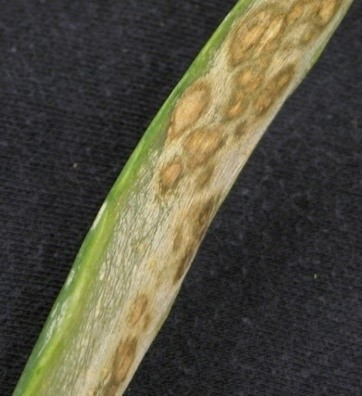Aug 6, 2018Protect onions against stemphylium leaf blight
Onion crops are affected by many different types of plant pathogens and must be protected. High relative humidity and frequent rainfall (or irrigation) in Michigan favor leaf blight. Even in a dry summer, overhead irrigation and high dew points can lead to moisture on the leaf surface, which allows pathogen spores to germinate and disease to develop.
Stemphylium leaf blight (Stemphylium vesicarium), historically, had been sporadically reported on onion foliage over the last 30 years and sometimes has been considered a secondary pathogen of blighted onion foliage. However, in recent years stemphylium leaf blight has emerged as a primary pathogen that has seemingly displaced Alternaria porri, the causal agent of purple blotch. S. vesicarium occurs as small, light yellow to brown, water-soaked lesions that turn dark with spores. Coalescing spots blight leaves, defoliating the crop and compromising bulb quality, leading to storage rot caused by secondary bacterial pathogens.
Research plots have been established with a grower cooperator this 2018 season to determine the most effective fungicides available to protect onion foliage. This research is supported through Project GREEEN. Treatments (see list below) have been applied in a controlled, replicated trial as foliar sprays every seven days for a total of five sprays to date this season. Treatments are applied using a CO2 backpack sprayer and a broadcast boom equipped with three XR8003 flat-fan nozzles spaced 18 inches apart, calibrated at 50 psi and delivering 50 gallons per acre. Disease was assessed for the first time on July 26 and the early results are noteworthy.
| Fungicides applied to onions in a field trial to limit Stemphylium foliar blight | ||
| Product | Active ingredients | FRAC* |
| Quadris Top SC | azoxystrobin/difenoconazole | 11/3 |
| Quadris SC | azoxystrobin | 11 |
| Aprovia Top | difenoconazole/benzovindiflupyr | 7/3 |
| Bravo WeatherStik SC | chlorothalonil | M05 |
| Manzate Pro-Stick | mancozeb | M03 |
| Luna Experience SC | fluopyram/tebuconazole | 7/3 |
| Luna Sensation SC | fluopyram/trifloxystron | 7/11 |
| Omega 500F | fluazinam | 29 |
| Tilt EC | propiconazole | 3 |
| Cabrio EG | pyraclostrobin | 11 |
| Pristine WG | pyraclostrobin/boscalid | 11/7 |
| Tebuzol 3.6F | tebuconazole | 3 |
* The Fungicide Resistance Action Committee (FRAC) developed a code of numbers and letters that can be used to distinguish the different fungicide groups based on their mode of action. To delay the development of resistance, alternate among fungicides with different FRAC codes.
In the untreated plots, the onion foliage already has 25 percent or more diseased and dead tissue. Both Luna-based fungicides (Luna Experience and Luna Sensation) are providing superior control. At this point, neither Quadris nor Cabrio are providing control compared to the untreated plot. For this first plot rating, I could not distinguish the untreated plot from those plots treated with Quadris or Cabrio. The Quadris Top treatment was better than Quadris. Bravo WS was much better than Manzate ProStik.
Other fungicides that were better than the untreated plot, but not as effective as the Luna-based fungicides, included Tilt, Tebuzol, Aprovia Top and Omega. The plots treated with Pristine appeared variable and more time is needed to determine the level of control that can be achieved with this treatment.
Based on these early results and the results from previous years’ studies, the following fungicides should be considered in an onion disease management program where Stemphylium leaf blight protection is needed:
- Luna Sensation, Luna Experience or Luna Tranquility
- Bravo
- Omega
- Tilt
- Tebuzol
- Approvia Top
Please keep in mind that the label must be adhered to and includes the maximum number of applications that can be applied including the number of sequential applications. The fungicide sprays should be alternated or rotated based on the FRAC code listed in the table above so that the pathogen doesn’t develop resistance to any one product.
– Mary Hausbeck, Benjamin Werling, Michigan State University
Photo at top: Stemphylium leaf blight. Photo by Mary Hausbeck, MSU Extension.















